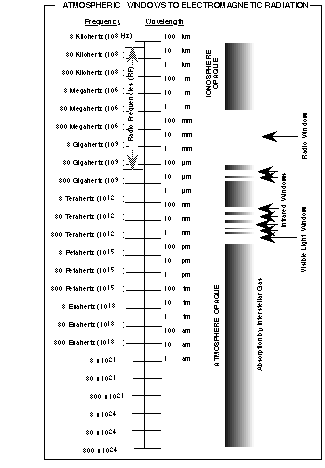Communications SystemHow does NASA communicate with spacecraft? |
One characteristic of electromagnetic radiation (radio waves, infrared, light, etc.) is that some frequencies can't pass through certain substances. Our atmosphere is made up of many different layers each made up of different substances. Most of the electromagnetic spectrum is absorbed by our atmosphere.
There are a few "windows" in our atmosphere's absorption that allow some electromagnetic radiation to get through. Some of these windows are what make it possible to see visible light and receive radio frequencies.

Figure from NASA's Jet Propulsion Laboratory's publication: Basics of Space
Flight Learner's Workbook. http://www-b.jpl.nasa.gov/basics/
Even when a signal can normally make it through the atmosphere, things like clouds or rain can absorb some of them. Visible light can pass through the atmosphere, for instance, but on cloudy days much of it is absorbed by the water in the sky. Thus, it is darker on rainy days than on clear ones.
One radio frequency that is affected in this way is the X-band frequency that is used by many deep space missions. This can be a problem if we are trying to receive a signal from the spacecraft. Any sort of precipitation--rain, snow, or even just lots of clouds--adds noise to the signal, and this can drive the signal-to-noise ratio too low to allow reception.
![]()
![]()
How are frequency and wavelength related?
How are gaps in data dealt with?
What new communications features is DS1 using?
Why does the data transfer rate have to drop with distance?
Why does communication get harder at greater distances?
How does reflection affect radio waves?
How much data is DS1 able to transfer?
![]()
![]()